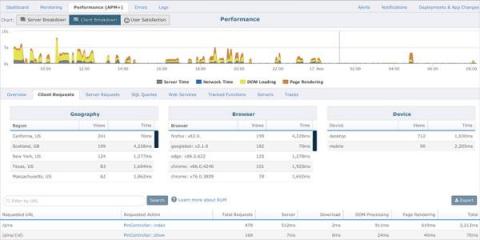Operations | Monitoring | ITSM | DevOps | Cloud
Stackify
Introduction to Prefix Featuring OpenTelemetry
Retrace Installation
Six OpenTelemetry Metrics to Track for Better Visibility
Metrics are an important component of monitoring and observability. They provide information about specific durations of measured occurrences. In OpenTelemetry (OTEL), metrics play a huge role in providing visibility into the performance and health of an application. It has become a de facto standard among cloud-native apps for monitoring and observability solutions. Hence understanding OpenTelemetry metrics and when to use them will help you optimize your observability efforts.
What is Retrace Application Performance Monitoring (APM)?
AI & Application Performance Monitoring Opportunities & Challenges
In today’s fast-paced world, app performance equals brand reputation. Customers expect apps that are fast, responsive and available 24/7. That’s where Application Performance Monitoring (APM) comes in. The technology enables businesses to ensure the best possible user experience by monitoring and managing the performance of their applications. But as applications become increasingly complex, identifying and resolving performance issues in real-time becomes increasingly difficult.
10 Best RUM Tools for Improving Your User Experience
Having user-friendly programs is paramount for any software company’s success. To gain a better understanding of your users’ experience and enjoyment, it’s vital that you learn how customers interact with your app or website. Real user monitoring (RUM) solutions enable your company to visualize how users interact with your software, helping you learn what works best for your customers so you can thrive against the competition.
Combining APM and RUM to Improve Your User Experience
Providing an intuitive user experience that caters to your audience’s needs is essential for your business. By combining APM and RUM, you can help eliminate application issues and give your users a seamless experience. Combining APM and RUM helps you look at both the front-end and back-end of your application, find and fix issues. Don’t quite know what APM and RUM are? Let’s take a closer look.
4 API Security Best Practices To Safeguard Sensitive Data
Thanks to the increasing usage of different software solutions, API usage has become an everyday practice. As such, API security is a more prevalent issue in app development than ever before. SaaS companies have an average of 350 integrations, whereas major SaaS companies like Slack, Zoom and Shopify have 2,000+ integrations. This is great for developers and end users, as Application Programming Interfaces (API) make life easier.
Mobile Cloud Computing: Overview, Challenges and Scope
The process of delivering mobile apps utilizing cloud technology is known as mobile cloud computing (MCC). Complex mobile apps today carry out activities including authentication, location-aware features and providing users with customized communication and content. As long as your device is online, mobile cloud computing enables you to store and access data anywhere. This makes it possible for data to be sent without difficulty anytime required.











